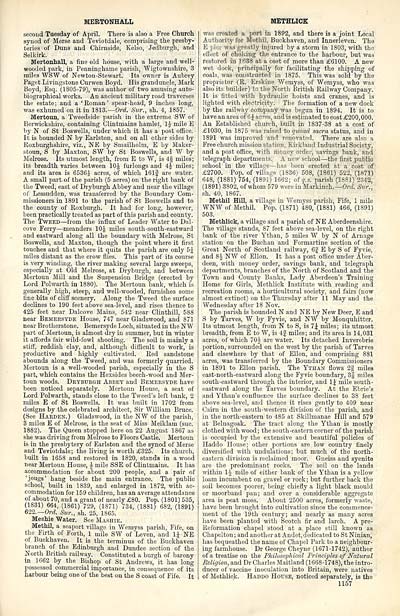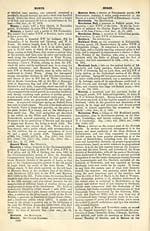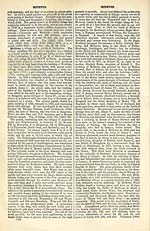Ordnance gazetteer of Scotland
(1165) Page 1157
Download files
Complete book:
Individual page:
Thumbnail gallery: Grid view | List view

MERTONHALL
second Tuesday of April. There is also a Free Church
synod of Merse and Teviotdale, comprising the presby-
teries of Duns and Chirnside, Kelso, Jedburgh, and
Selkirk.
Mertonhall, a fine old house, with a large and well-
wooded park, in Penninghame parish, Wigtownshire, 3
miles WSW of Newton-Stewart. Its owner is Aubrey
Paget Livingstone Curwen Boyd. His granduncle, Mark
Boyd, Esq. (1805-79), was author of two amusing auto-
biographical works. An ancient military road traverses
the estate ; and a ' Roman ' spear-head, 9 inches long,
was exhumed on it in 1813. — Ord. Sur., sh. 4, 1857.
Mertoun, a Tweedside parish in the extreme SW of
Berwickshire, containing Clintmains hamlet, 1§ mile E
by N of St Boswells, under which it has a post office.
It is bounded N by Earlston, and on all other sides by
Roxburghshire, viz., NE by Smailholm, E by Maker-
stoun, S by Maxton, SW by St Boswells, and W by
Melrose. Its utmost length, from E to W, is 4g miles;
its breadth varies between 10J furlongs and 4J miles;
and its area is 6536^ acres, of which 161f are water.
A small part. of the parish (5 acres) on the right bank of
the Tweed, east of Dryburgh Abbey and near the village
of Lessudden, was transferred by the Boundary Com-
missioners in 1891 to the parish of St Boswells and to
the county of Roxburgh. It had for long, however,
been practically treated as part of this parish and county.
The Tweed — from the influx of Leader Water to Dal-
cove Ferry — meanders 10J miles south-south-eastward
and eastward along all the boundary with Melrose, St
Boswells, and Maxton, though the point where it first
touches and that where it quits the parish are only 5J
miles distant as the crow flies. This part of its course
is very winding, the river making several large sweeps,
especially at Old Melrose, at Dryburgh, and between
Mertoun Mill and the Suspension Bridge (erected by
Lord Polwarth in 1880). The Mertoun bank, which is
generally high, steep, and well-wooded, furnishes some
fine bits of cliff scenery. Along the Tweed the surface
declines to 190 feet above sea-level, and rises thence to
425 feet near Dalcove Mains, 542 near Clinthill, 588
near Bemersyde House, 747 near Gladswood, and 871
near Brotherstone. Bemersyde Loch, situated in the KW
part of Mertoun, is almost dry in summer, but in winter
it affords fair wild-fowl shooting. The soil is mainly a
stiff, reddish clay, and, although difficult to work, is
productive and highly cultivated. Red sandstone
abounds along the Tweed, and was formerly quarried.
Mertoun is a well-wooded parish, especially in the S
part, which contains the Hexsides beech-wood and Mer-
toun woods. Dryburgh Abbey and Bemersyde have
been noticed separately. Mertoun House, a seat of
Lord Polwarth, stands close to the Tweed's left bank, 2
miles E of St Boswells. It was built in 1702 from
designs by the celebrated architect, Sir William Bruce.
(See Harden.) Gladswood, in the NW of the parish,
3 miles E of Melrose, is the seat of Miss Meiklam (sue.
1882). The Queen stopped here on 22 August 1867 as
she was driving from Melrose to Floors Castle. Mertoun
is in the presbytery of Earlston and the synod of Merse
and Teviotdale; the living is worth £325. Its church,
built in 1658 and restored in 1820, stands in a wood
near Mertoun House, i mile SSE of Clintmains. It has
accommodation for about 200 people, and a pair of
'jougs' hang beside the main entrance. The public
school, built in 1839, and enlarged in 1872, with ac-
commodation for 159 children, has an average attendance
of about 70, and a grant of nearly £80. Pop. (1801) 535,
(1831) 664, (1861) 729, (1871) 734, (1881) 682, (1891)
622.-Ord. Sur., sh. 25, 1865.
Meshie Water. See Mashie.
Methil, a seaport village in Wemyss parish, Fife, on
the Firth of Forth, 1 mile SW of Leven, and 1J NE
of Buckhaven. It is the terminus of the Buckhaven
branch of the Edinburgh and Dundee section of the
North British railway. Constituted a burgh of barony
in 1662 by the Bishop of St Andrews, it has long
possessed commercial importance, in consequence of its
harbour being one of the best on the S coast of Fife. It
METHLICK
was created a port in 1892, and there is a joint Local
Authority for Methil, Buckhaven, and Innerleven. The
E pier was greatly injured by a storm in 1803, with the
effect of choking the entrance to the harbour, but was
restored ill 1888 at a cost of more than £6100. A new
wet dock, principally for facilitating the shipping of
coals, was constructed in 1875. This was sold by the
proprietor (R. Ei-skine Wemyss, of Wemyss, who was
also its builder) to the North British Railway Company.
It is fitted with hydraulic hoists and cranes, and is
lighted with electricity. The formation of a new dock
by the railway company was begun in 1894. It is to
have an area of 6| acres, and is estimated to cost £200,000.
An Established church, built in 1837-38 at a cost of
£1030, in 1875 was raised to quoad sacra status, and in
1891 was improved and renovated. There are also a
Free church mission station, Kirkland Industrial Society,
and a post office, with money order, savings bank, and
telegraph departments. A new school — the first public
school in the village — has been erected at a cost of
£2700. Pop. of village (1836) 508, (1861) 522, (1871)
648, (1881) 754, (1891) 1662; of q.s. parish (1881) 2342,
(1891) 3802, of whom 579 were in Markinch.— Ord. Sur.,
sh. 40, 1867.
Methil Hill, a village in Wemyss parish, Fife, 1 mile
WNW of Methil. Pop. (1871) 480, (1881) 466, (1891)
503.
Methlick, a village and a parish of NE Aberdeenshire.
The village stands, 87 feet above sea-level, on the right
bank of the river Ythan, 5 miles W by N of Arnage
station on the Buchan and Formartine section of the
Great North of Scotland railway, 6 j E by S of Fyvie,
and 8i NW of Ellon. It has a post office under Aber-
deen, with money order, savings bank, and telegraph
departments, branches of the North of Scotland and the
Town and County Banks, Lady Aberdeen's Training
Home for Girls, Methlick Institute with reading and
recreation rooms, a horticultural society, and fairs (now
almost extinct) on the Thursday after 11 May and the
Wednesday after 18 Nov.
The parish is bounded N and NE by New Deer, E and
S by Tarves, W by Fyvie, and NW by Monquhitter.
Its utmost length, from N to S, is 7% miles; its utmost
breadth, from E to W, is 4f miles; and its area is 14,031
acres, of which 70i are water. Its detached Inverebrie
portion, surrounded on the west by the parish of Tarves
and elsewhere by that of Ellon, and comprising 881
acres, was transferred by the Boundary Commissioners
in 1891 to Ellon parish. The Ythan flows 2§ miles
east-north-eastward along the Fyvie boundary, 3J miles
south-eastward through the interior, and 14j mile south-
eastward along the Tarves boundary. At the Ebrie's
and Ythan's confluence the surface declines to 38 feet
above sea-level, and thence it rises gently to 409 near
Cairn in the south-western division of the parish, and
in the north-eastern to 485 at Skillmanae Hill and 579
at Belnagoak. The tract along the Ythan is mostly
clothed with wood ; the south-eastern corner of the parish
is occupied by the extensive and beautiful policies of
Haddo House; other portions are low country finely
diversified with undulations; but much of the north-
eastern division is reclaimed moor. Gneiss and syenite
are the predominant rooks. The soil on the lands
within \\ mile of either bank of the Ythan is a yellow
loam incumbent on gravel or rock; but further back the
soil becomes poorer, being chiefly a light black mould
or moorband pan; and over a considerable aggregate
area is peat moss. About 2500 acres, formerly waste,
have been brought into cultivation since the commence-
ment of the 19th century; and nearly as many acres
have been planted with Scotch fir and larch. A pre-
Reformation chapel stood at a place still known as
Chapel ton ; and another at Andet, dedicated to St Ninian,
has bequeathed the name of Chapel Park to a neighbour-
ing farmhouse. Dr George Cheyne (1671-1742), author
of a treatise on the Philosophical Principles of Natural
Religion, and Dr Charles Maitland (1668-1748), the intro-
ducer of vaccine inoculation into Britain, were natives
of Methlick. Haddo House, noticed separately, is the
1157
second Tuesday of April. There is also a Free Church
synod of Merse and Teviotdale, comprising the presby-
teries of Duns and Chirnside, Kelso, Jedburgh, and
Selkirk.
Mertonhall, a fine old house, with a large and well-
wooded park, in Penninghame parish, Wigtownshire, 3
miles WSW of Newton-Stewart. Its owner is Aubrey
Paget Livingstone Curwen Boyd. His granduncle, Mark
Boyd, Esq. (1805-79), was author of two amusing auto-
biographical works. An ancient military road traverses
the estate ; and a ' Roman ' spear-head, 9 inches long,
was exhumed on it in 1813. — Ord. Sur., sh. 4, 1857.
Mertoun, a Tweedside parish in the extreme SW of
Berwickshire, containing Clintmains hamlet, 1§ mile E
by N of St Boswells, under which it has a post office.
It is bounded N by Earlston, and on all other sides by
Roxburghshire, viz., NE by Smailholm, E by Maker-
stoun, S by Maxton, SW by St Boswells, and W by
Melrose. Its utmost length, from E to W, is 4g miles;
its breadth varies between 10J furlongs and 4J miles;
and its area is 6536^ acres, of which 161f are water.
A small part. of the parish (5 acres) on the right bank of
the Tweed, east of Dryburgh Abbey and near the village
of Lessudden, was transferred by the Boundary Com-
missioners in 1891 to the parish of St Boswells and to
the county of Roxburgh. It had for long, however,
been practically treated as part of this parish and county.
The Tweed — from the influx of Leader Water to Dal-
cove Ferry — meanders 10J miles south-south-eastward
and eastward along all the boundary with Melrose, St
Boswells, and Maxton, though the point where it first
touches and that where it quits the parish are only 5J
miles distant as the crow flies. This part of its course
is very winding, the river making several large sweeps,
especially at Old Melrose, at Dryburgh, and between
Mertoun Mill and the Suspension Bridge (erected by
Lord Polwarth in 1880). The Mertoun bank, which is
generally high, steep, and well-wooded, furnishes some
fine bits of cliff scenery. Along the Tweed the surface
declines to 190 feet above sea-level, and rises thence to
425 feet near Dalcove Mains, 542 near Clinthill, 588
near Bemersyde House, 747 near Gladswood, and 871
near Brotherstone. Bemersyde Loch, situated in the KW
part of Mertoun, is almost dry in summer, but in winter
it affords fair wild-fowl shooting. The soil is mainly a
stiff, reddish clay, and, although difficult to work, is
productive and highly cultivated. Red sandstone
abounds along the Tweed, and was formerly quarried.
Mertoun is a well-wooded parish, especially in the S
part, which contains the Hexsides beech-wood and Mer-
toun woods. Dryburgh Abbey and Bemersyde have
been noticed separately. Mertoun House, a seat of
Lord Polwarth, stands close to the Tweed's left bank, 2
miles E of St Boswells. It was built in 1702 from
designs by the celebrated architect, Sir William Bruce.
(See Harden.) Gladswood, in the NW of the parish,
3 miles E of Melrose, is the seat of Miss Meiklam (sue.
1882). The Queen stopped here on 22 August 1867 as
she was driving from Melrose to Floors Castle. Mertoun
is in the presbytery of Earlston and the synod of Merse
and Teviotdale; the living is worth £325. Its church,
built in 1658 and restored in 1820, stands in a wood
near Mertoun House, i mile SSE of Clintmains. It has
accommodation for about 200 people, and a pair of
'jougs' hang beside the main entrance. The public
school, built in 1839, and enlarged in 1872, with ac-
commodation for 159 children, has an average attendance
of about 70, and a grant of nearly £80. Pop. (1801) 535,
(1831) 664, (1861) 729, (1871) 734, (1881) 682, (1891)
622.-Ord. Sur., sh. 25, 1865.
Meshie Water. See Mashie.
Methil, a seaport village in Wemyss parish, Fife, on
the Firth of Forth, 1 mile SW of Leven, and 1J NE
of Buckhaven. It is the terminus of the Buckhaven
branch of the Edinburgh and Dundee section of the
North British railway. Constituted a burgh of barony
in 1662 by the Bishop of St Andrews, it has long
possessed commercial importance, in consequence of its
harbour being one of the best on the S coast of Fife. It
METHLICK
was created a port in 1892, and there is a joint Local
Authority for Methil, Buckhaven, and Innerleven. The
E pier was greatly injured by a storm in 1803, with the
effect of choking the entrance to the harbour, but was
restored ill 1888 at a cost of more than £6100. A new
wet dock, principally for facilitating the shipping of
coals, was constructed in 1875. This was sold by the
proprietor (R. Ei-skine Wemyss, of Wemyss, who was
also its builder) to the North British Railway Company.
It is fitted with hydraulic hoists and cranes, and is
lighted with electricity. The formation of a new dock
by the railway company was begun in 1894. It is to
have an area of 6| acres, and is estimated to cost £200,000.
An Established church, built in 1837-38 at a cost of
£1030, in 1875 was raised to quoad sacra status, and in
1891 was improved and renovated. There are also a
Free church mission station, Kirkland Industrial Society,
and a post office, with money order, savings bank, and
telegraph departments. A new school — the first public
school in the village — has been erected at a cost of
£2700. Pop. of village (1836) 508, (1861) 522, (1871)
648, (1881) 754, (1891) 1662; of q.s. parish (1881) 2342,
(1891) 3802, of whom 579 were in Markinch.— Ord. Sur.,
sh. 40, 1867.
Methil Hill, a village in Wemyss parish, Fife, 1 mile
WNW of Methil. Pop. (1871) 480, (1881) 466, (1891)
503.
Methlick, a village and a parish of NE Aberdeenshire.
The village stands, 87 feet above sea-level, on the right
bank of the river Ythan, 5 miles W by N of Arnage
station on the Buchan and Formartine section of the
Great North of Scotland railway, 6 j E by S of Fyvie,
and 8i NW of Ellon. It has a post office under Aber-
deen, with money order, savings bank, and telegraph
departments, branches of the North of Scotland and the
Town and County Banks, Lady Aberdeen's Training
Home for Girls, Methlick Institute with reading and
recreation rooms, a horticultural society, and fairs (now
almost extinct) on the Thursday after 11 May and the
Wednesday after 18 Nov.
The parish is bounded N and NE by New Deer, E and
S by Tarves, W by Fyvie, and NW by Monquhitter.
Its utmost length, from N to S, is 7% miles; its utmost
breadth, from E to W, is 4f miles; and its area is 14,031
acres, of which 70i are water. Its detached Inverebrie
portion, surrounded on the west by the parish of Tarves
and elsewhere by that of Ellon, and comprising 881
acres, was transferred by the Boundary Commissioners
in 1891 to Ellon parish. The Ythan flows 2§ miles
east-north-eastward along the Fyvie boundary, 3J miles
south-eastward through the interior, and 14j mile south-
eastward along the Tarves boundary. At the Ebrie's
and Ythan's confluence the surface declines to 38 feet
above sea-level, and thence it rises gently to 409 near
Cairn in the south-western division of the parish, and
in the north-eastern to 485 at Skillmanae Hill and 579
at Belnagoak. The tract along the Ythan is mostly
clothed with wood ; the south-eastern corner of the parish
is occupied by the extensive and beautiful policies of
Haddo House; other portions are low country finely
diversified with undulations; but much of the north-
eastern division is reclaimed moor. Gneiss and syenite
are the predominant rooks. The soil on the lands
within \\ mile of either bank of the Ythan is a yellow
loam incumbent on gravel or rock; but further back the
soil becomes poorer, being chiefly a light black mould
or moorband pan; and over a considerable aggregate
area is peat moss. About 2500 acres, formerly waste,
have been brought into cultivation since the commence-
ment of the 19th century; and nearly as many acres
have been planted with Scotch fir and larch. A pre-
Reformation chapel stood at a place still known as
Chapel ton ; and another at Andet, dedicated to St Ninian,
has bequeathed the name of Chapel Park to a neighbour-
ing farmhouse. Dr George Cheyne (1671-1742), author
of a treatise on the Philosophical Principles of Natural
Religion, and Dr Charles Maitland (1668-1748), the intro-
ducer of vaccine inoculation into Britain, were natives
of Methlick. Haddo House, noticed separately, is the
1157
Set display mode to: Large image | Transcription
Images and transcriptions on this page, including medium image downloads, may be used under the Creative Commons Attribution 4.0 International Licence unless otherwise stated. ![]()
| Gazetteers of Scotland, 1803-1901 > Ordnance gazetteer of Scotland > (1165) Page 1157 |
|---|
| Permanent URL | https://digital.nls.uk/97407226 |
|---|

